Free VIN Decoder & VIN Number Lookup
Buying or selling a vehicle? Use a VIN decoder to get full access to vehicle specifications, including the year, make, model, engine specs, transmission, drive type, and even past history records. Check now!
What is a VIN (Vehicle Identification Number)?
The VIN is a unique code that is unique to every vehicle made. The VIN contains details about the vehicle’s year, make, model, engine type, transmission and drive type among other information.
You can also use the VIN to check for thefts, accidents, services, title brand records, stolen records, and much other information.
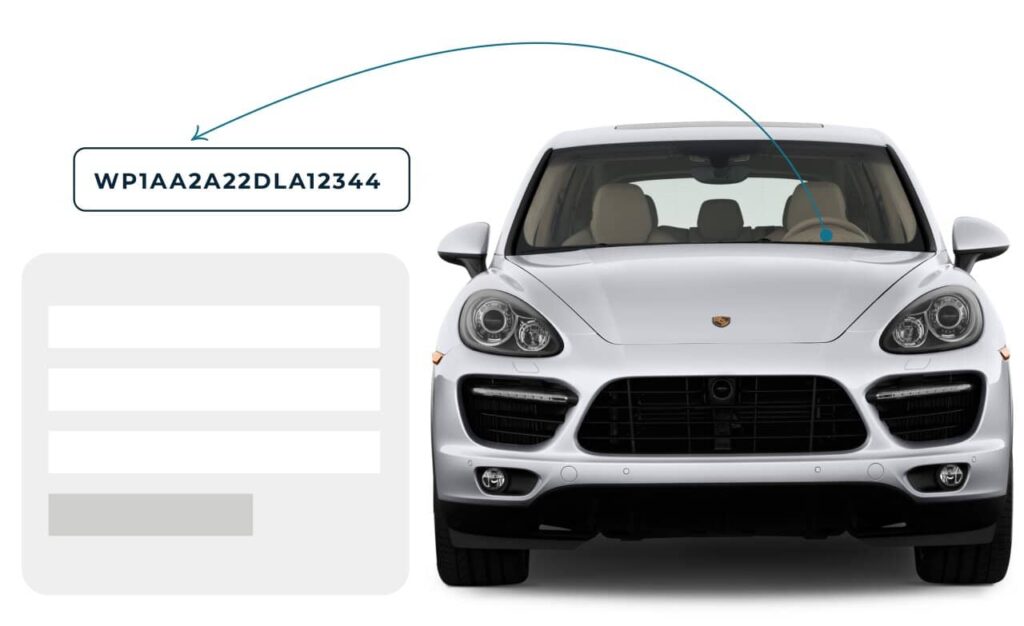
What is a VIN Decoder?
A VIN decoder is a tool that reads the 17-character Vehicle Identification Number and translates it into useful information about the vehicle.
Each character in the VIN has a purpose, so the decoder can identify things like the model year, engine type, transmission, body style, safety features, and where the vehicle was built. It gives you an accurate snapshot of what the vehicle was when it left the factory.
With the VIN decoder, car buyers and sellers can also view past history records like accidents, damages, theft records, ownership history, and more. This helps in making better decisions and car valuations.
Why Do You Need a VIN Decoder?
A VIN decoder is important for both buyers and sellers because they can get full access to not only vehicle specs but also history records. With this, car buyers can make informed decisions, and sellers can have better listings and more sales.
Other benefits of a VIN decoder are:
Car Buyers
- Avoid Fraudulent Listings: A VIN decoder checks if the car details match the seller’s claims. This guards you against phony listings or untrustworthy sellers.
- Check All History Records: You can look up accident records, changes in ownership, theft records, and safety recalls before you buy.
- Compare Several Options: With accurate specs and history, you can weigh your options and pick the car that gives you the most value.
Sellers and Dealerships
- Set Fair Prices: A VIN decoder helps dealers tag cars with the right price and correct specs in ads leading to quicker sales.
- Win Customer Trust: By offering confirmed VIN specs and history, dealerships show they have nothing to hide and earn buyers’ trust.
- Saves Time & Effort: Rather than digging up specs or searching through documents, a VIN decoder displays all the details in a flash.
What Information Can You Get from a VIN Decoder?
With a VIN decoder, you can get full access to useful information that a seller may forget to mention with the listing. Here’s what you can get with a VIN decoder:
Vehicle Specifications
A good starting point is knowing exactly what the vehicle is. Listings can be vague or even mistaken, so this section gives you the correct factory build information.
What You’ll Usually Find
- Year, make, and model
- Trim level and body style
- Engine type and displacement
- Transmission type
- Drive configuration such as FWD, RWD, or 4WD
- Fuel type
- Manufacturer country and production details
This information makes it easier to compare vehicles and confirm that the seller’s description matches the actual vehicle.
Ownership History
Ownership history helps you understand how stable the vehicle has been over time. Long-term ownership often points to a well-cared-for car, while short cycles can suggest something worth looking into.
What This Section Typically Includes
- Number of owners
- Each owner’s state or region
- Purchase and transfer dates
- Length of ownership
- Usage type such as personal, fleet, or rental
This timeline offers helpful clues about how the vehicle may have been treated and how frequently it changed hands.
Mileage History
Mileage plays a big role in a vehicle’s value, so a VIN decoder tracks recorded readings across different stages of the vehicle’s life. It helps you see whether the numbers line up naturally or raise questions.
What You Can Expect to See
- Early mileage readings at registration
- Consistent increases over time
- Mileage entries from inspections or title updates
- Flags for unusually high or inconsistent readings
Patterns like sudden jumps, repeats, or implausible numbers often suggest the need for a closer look.
Accident History
Accidents happen, and they are not always disclosed in listings. This section gives you documented events that help clarify the vehicle’s past condition.
What Accident Records Often Show
- Date of the incident
- Reporting state or county
- Nature of the collision
- Notes on airbag deployment
- Case numbers or agency references
This information helps you understand the severity of the event and whether additional inspection might be worthwhile.
Recalls Check
Manufacturers release recalls to fix safety or performance issues. A VIN decoder can show whether the vehicle still has upcoming or incomplete recall repairs.
What This Area Includes
- Number of open recalls
- Confirmation when no recalls are pending
- Categories of recalled components
Knowing whether a recall is unresolved helps you plan for future repairs or dealer visits.
Title Brand Records
Title brands tell a deeper story about the vehicle’s legal and structural condition. They help you see what has been recorded at the state level.
Common Title Brands Identified
- Salvage
- Rebuilt
- Flood or water damage
- Fire or hail damage
- Junk or scrapped
- Odometer rollback
- Lemon or manufacturer buyback
These records can affect both value and safety, so they are important to check.
Theft Records
Stolen vehicles sometimes make their way back into the market years later. A theft record is something buyers should always be aware of.
What You’ll Find Here
- Whether the vehicle has ever been reported stolen
- Whether it was recovered or still listed as missing
- Dates tied to theft or recovery events
Even a recovered vehicle may have insurance or title concerns that matter during a purchase.
Warranty Status
Some VIN decoders include basic warranty information to help you understand whether any factory coverage might still apply.
Warranty Details Typically Shown
- Basic warranty term
- Powertrain coverage
- Corrosion protection
- Roadside assistance duration
This can be helpful when estimating ownership costs or planning upcoming repairs.
Auction History
Auction entries give a more candid look at the vehicle’s condition during resale moments when sellers cannot hide flaws. These records are often valuable for buyers.
Auction Details You Might See
- Auction date and location
- Sale price
- Condition notes such as primary and secondary damage
- Whether the vehicle started or ran
- Number of photos taken at auction
Auction photos often disclose things you will not see in a normal listing.
Sales History
Some VIN decoders include previous online listings, which help you understand how often the vehicle has been up for sale.
What Sales Records Can Show
- Number of times listed
- Condition at each listing
- Photos from past listings
Frequent listings in a short period may indicate underlying issues.
Service Records
Service entries can help paint a clearer picture about maintenance habits. While not every service shop reports data, recorded entries are useful for evaluating care.
Typical Service Items
- Scheduled maintenance
- Part replacements
- Major or minor repairs
- Notes from inspections
A consistent service pattern is usually a positive sign.
Liens and Loans
Liens can create complications during a purchase if not resolved. A VIN decoder helps identify these issues early.
Lien Details Often Listed
- Number of lien records
- Filing dates
- States where liens were recorded
- Notes indicating whether they may still be active
This section helps protect buyers from unexpected legal or financial problems.
How a VIN Report Saved a Buyer From a Bad Purchase
Before looking at Mark’s story, here is a quick overview of how common hidden issues are in the used car market:
About 40% of cars on the road have some form of accident or damage record.
Over 1 million vehicles were reported stolen in the past year.
More than 450,000 vehicles have cases of odometer rollback each year.
Several million cars nationwide have salvage or rebuilt titles in circulation.
With all these in mind, Mark decided to get a quick report with a VIN decoder before paying for a used 2015 Jeep Wrangler that looked clean in the photos.
What the Report Revealed
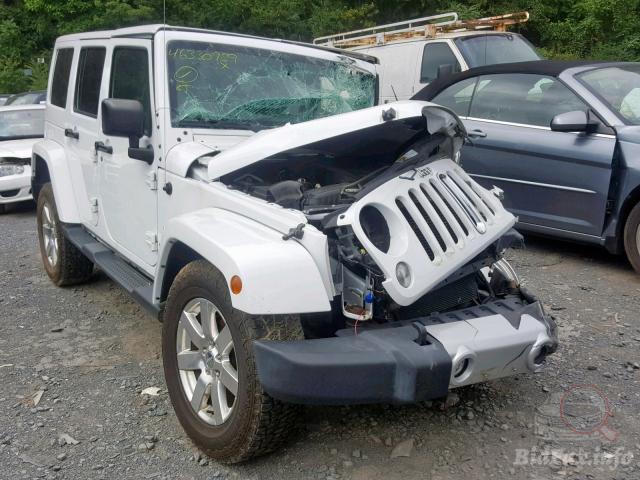
- Report Finding
- Branded title showing salvage history
- Collision record with air bag deployment
- Auction entry showing “all over” damage
- Mileage jump to 999,999 at auction
- Multiple lien records
- What It Meant for Mark
- The Jeep had a serious past that the seller never mentioned
- Higher risk of structural issues and long-term repair concerns
- The vehicle had been through a major event before being resold
- A clear sign that the odometer could not be trusted
- Extra legal steps and potential delays if he moved forward
Putting everything together helped Mark step back and rethink the purchase. If he had gone through with it, he would have paid close to 8,000 dollars more than the Jeep was truly worth in its condition.
How to Read a Vehicle Identification Number (VIN)
VINs may look like random letters and numbers but these characters are divided into different parts, each telling you something important.
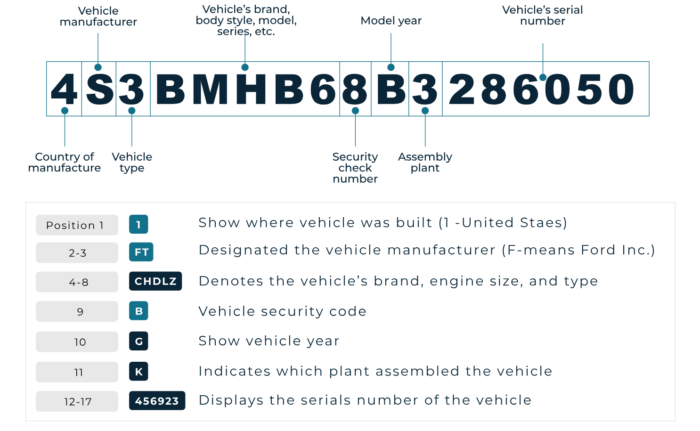
Here’s what the characters of a VIN represent:
WMI (World Manufacturer Identifier)
The first three characters of the VIN are called the WMI. This section tells you the country where the vehicle was built and the manufacturer’s name. For example:
- “1” means the vehicle was made in the USA.
- “J” means Japan.
- “W” means Germany.
So if you see “1HG,” that means Honda made the car in the USA.
Here are some more examples to help you easily decode where a vehicle was built based on the first character of it’s VIN:
| Character | Region | Country |
|---|---|---|
| A-H | Africa | AA-AH = South Africa |
| J-R | Asia | J = Japan/ KL-KR = South Korea L = China MA-ME = India MF-MK = Indonesia ML-MR = Thailand MS = Myanmar PA-PE = Philippines PL-PR = Malaysia RF-RG = Taiwan |
| S-Z | Europe | SA-SM = United Kingdom SN-ST, W = Germany SU-SZ = Poland TA-TH = Switzerland TJ-TP = Czech Republic TR-TV = Hungary TW = Portugal VA-VE = Austria VF-VR = France VS-VW = Spain VX-V2 = Yugoslavia XL-XM = The Netherlands XS-XW = USSR X3-X0 = Russia YA-YE = Belgium YF-YK = Finland YS-YW = Sweden ZA-ZR = Italy |
| 1-5 | North America | 1, 4, 5 = United States 2 = Canada 3 = Mexico |
| 6-7 | Oceania | 6A-6W = Australia 7A-7E = New Zealand |
| 8-0 | South America | 8A-8E = Argentina 8F-8J = Chile 8X-82 = Venezuela 9A-9E, 93-99 = Brazil 9F-9J = Colombia |
VDS (Vehicle Descriptor Section)
The next six characters in the VIN are grouped into the VDS. This part of the number helps describe the vehicle in a more detailed way. It brings together information that tells you what the vehicle was designed to be and how it was originally built.
What Characters 4 to 8 Commonly Represent
- Model or series
- Engine type or size
- Restraint systems such as airbags or seatbelt types
- Body style, such as sedan, coupe, or SUV
- Transmission type
- Additional features coded by the manufacturer
The 9th character is a check digit. It is used to verify the VIN and confirm that the number is valid. If the check digit does not match the calculation used by manufacturers and regulators, it usually means the VIN has errors or has been altered.
VIS (Vehicle Identifier Section)
The final eight characters of the VIN make up the VIS. This part focuses on identifying the vehicle as an individual unit rather than simply describing the model line.
What Characters 10 to 17 Indicate
- 10th character: model year
- 11th character: assembly plant or factory code
- Characters 12 to 17: sequence or serial number for that exact vehicle
Together, these characters help separate one vehicle from another, even when thousands of identical models roll off the same production line.
VIN Anatomy Explained With an Example
Take a look at the breakdown of this VIN: 1G1JA5SH4E4153457
| Character | VIN | What It Reveals |
|---|---|---|
| 1st | 1 | Manufacturing country — United States |
| 2nd–3rd | G1 | Vehicle manufacturer — General Motors (Chevrolet) |
| 4th–8th | JA5SH | Model details including the engine, body type, restraint system, etc. |
| 9th | 4 | Security check digit used to verify VIN validity |
| 10th | E | Model year — 2014 |
| 11th | 4 | Assembly plant |
| 12th–17th | 153457 | Unique serial number identifying the specific vehicle |
Year Chart Code from VIN Number
Wondering how to quickly find your vehicle’s model year using its VIN number? Simply match the 10th digit of your VIN to the code below to find out your car’s exact model year.
| 10th Digit | Model Year | 10th Digit | Model Year | 10th Digit | Model Year | 10th Digit | Model Year |
|---|---|---|---|---|---|---|---|
| A | 1980 | M | 1991 | 2 | 2002 | D | 2013 |
| B | 1981 | N | 1992 | 3 | 2003 | E | 2014 |
| C | 1982 | P | 1993 | 4 | 2004 | F | 2015 |
| D | 1983 | R | 1994 | 5 | 2005 | G | 2016 |
| E | 1984 | S | 1995 | 6 | 2006 | H | 2017 |
| F | 1985 | T | 1996 | 7 | 2007 | J | 2018 |
| G | 1986 | V | 1997 | 8 | 2008 | K | 2019 |
| H | 1987 | W | 1998 | 9 | 2009 | L | 2020 |
| J | 1988 | X | 1999 | A | 2010 | M | 2021 |
| K | 1989 | Y | 2000 | B | 2011 | N | 2022 |
| L | 1990 | 1 | 2001 | C | 2012 | P | 2023 |
Where Do I Find the VIN in My Car?
The VIN is usually printed or engraved on parts of the car that are easy to identify. Some common locations you can check, include:
- On the dashboard of the vehicle.
- Inside the driver’s side door.
- On the engine block.
- On the frame of the car.
- On vehicle documents like the title, registration, or insurance papers.
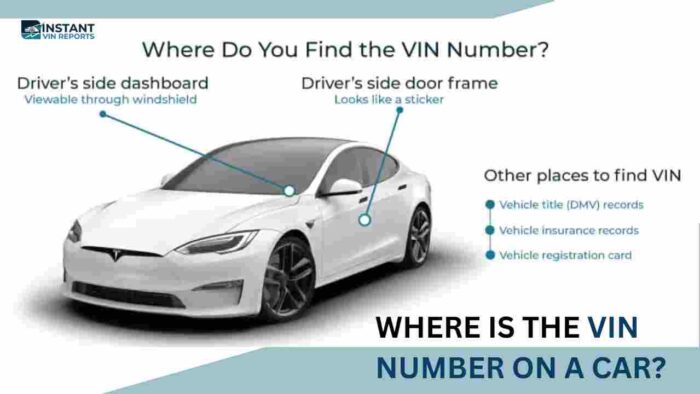
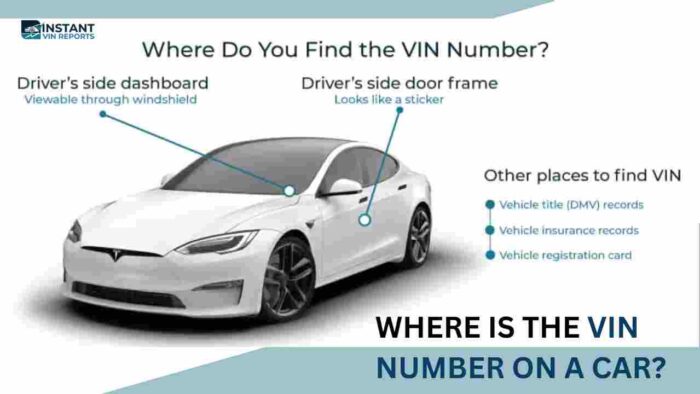
VIN Locations on Motorcycles, ATVs, and Similar Vehicles
Motorcycles and off-road vehicles follow slightly different placement rules, although the idea is still the same. The VIN is placed somewhere permanent on the frame so it stays readable for the lifetime of the machine.
If you are checking one of these vehicles, here are the most common spots to look at:
- On the steering head or neck of the motorcycle
- Stamped on the frame near the handlebars
- Near the engine casing or on the lower frame rail for dirt bikes
- On the front or rear frame for ATVs and UTVs
- On metal plates riveted to the frame for certain scooters and smaller bikes
- On the manufacturer’s label under the seat
- On registration or insurance documents if the physical plate is hard to reach
How to Use The Free VIN Decoder
Do you know you can view vehicle specifications and features for free using our instant VIN decoder? Here are simple steps to follow to decode any VIN:
Locate the VIN
First, you need to find the VIN on the vehicle or on documents. If the VIN is unavailable, you can also use the license plate number.
Fill out the Form
Next, enter the 17-character VIN into the form and submit it. For older or classic cars, the VIN could be a bit shorter, usually 5 to 14 characters long.
Submit the Form
Now click on “Search VIN” to submit the form and decode the VIN.
Free VIN Decoder vs Full Vehicle History Report
A VIN decoder shows you vehicle specifications and features for free. However, to make informed decisions about a used vehicle, you need a full vehicle history report showing theft records, accident records, damages, liens and loans, and more.
Here’s what you can get with a free VIN decoder vs. a full vehicle history report.
| Data Included | Free VIN Decoder | Vehicle History Report |
|---|---|---|
| Basic VIN decoding (all vehicle types) | ||
| Vehicle year, make, model & trim | ||
| Detailed specifications (engine, body, etc.) | ||
| Market value estimate | ||
| Current sales listings | ||
| Auction results / history | ||
| Recorded mileage at sales/auctions | ||
| Complete ownership & usage history | ||
| Theft / stolen vehicle records | ||
| Previous owners | ||
| Salvage / junk status | ||
| Title branding (e.g., rebuilt, flood) | ||
| Odometer rollback check | ||
| Loan or lien status | ||
| Vehicle usage type (personal, fleet, etc.) | ||
| Service and maintenance records | ||
| Open recalls from manufacturer |
Decode VIN Numbers Across All Brands
Whether it’s Toyota, Ford, BMW, or Tesla, VIN decoders can work for all car brands and models. Some popular brands are:
Frequently Asked Questions About VIN Decoder
What is a VIN?
A VIN is a unique identifier assigned to every vehicle during manufacture. The VIN holds information about the vehicle’s year, make, model, engine specs, transmission, drive type, and more. The VIN can also be decoded to view past records including theft records, accidents, service records, title brand records, and more.
How can I decode my vehicle's VIN?
To decode your vehicle’s VIN, just find your VIN number and put it in the VIN decoder form on this page. After you submit it, it will show car specifications and history records.
Is the VIN check really free?
Yes, a basic VIN decoding is free. You’ll get specs like year, make, model, trim, and engine details at no cost. But if you need the full history including accidents, title records, theft checks, liens, service history, and more, you’ll need a paid vehicle history report.
Is using a free online VIN decoder safe and legal?
Yes, using a free online VIN decoder is safe and 100% legal. The data we provide with VIN checks are public data and not personal data.
Can I use this tool to decode chassis numbers?
Yes, you can use this tool to decode chassis numbers. A chassis number is the same as the VIN number, and so it can be easily decoded with a VIN decoder. Simply fill out the form on this page to decode yours.
How do I use a free VIN decoder?
To use a free VIN decoder, you need to find the VIN and enter it into the form on this page. Next, submit the form, and the VIN will be decoded to show all specs, features, and history records.
Does a VIN decoder show theft or fraud records?
Yes, many VIN decoders include theft information when it has been reported through official channels. You can see if the vehicle was ever marked as stolen, whether it was recovered, and if there are any records that suggest fraud, such as mileage inconsistencies or suspicious title changes.
What if my VIN has fewer than 17 characters?
If your VIN has fewer than 17 characters, the vehicle is usually older or considered a classic. Cars built before 1981 used shorter VIN formats, and those numbers can still be decoded with our classic VIN decoder.
Is it safe to share my VIN publicly when selling a car?
Yes, sharing your VIN is generally safe and is a normal part of selling a vehicle. Buyers often ask for the VIN so they can check the specifications and history before making a decision. The VIN does not reveal personal information about you. It only identifies the vehicle and its records, which helps create transparency and trust during the sale.

